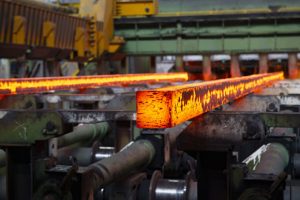EU to Take in Ukrainian Steel With New Tariff Adjustments
NOTE: This story was updated on 6.7.22
The European Commission (EC) has extended its existing safeguard tariffs on steel to June 30, 2024, but with some adjustments. In a letter to the WTO, the executive body for the 27-member group said the annual rate of liberalization is due to increase from 3% to 4% as of July 1. Liberalization is the degree by which the quota lowers. To that point, the EC also adopted a regulation to allow for temporary trade liberalization on Ukrainian steel.
In its June 3rd issue, the Official Journal of the European Union specifically noted Ukraine’s removal from the safeguards. This meant the changes would go into effect the very next day. It’s an important move in a lot of ways, as Ukraine’s economy is already suffering greatly under the weight of the Russian invasion.
Get all the latest metals market news, from steel and copper to REM and more. Sign up for the weekly MetalMiner newsletter here.
Ukrainian Steel Receives Special Consideration
Imports of Ukrainian steel into the bloc have largely ceased since Russia began its military invasion of the country on Feb. 24. Since that time, EC has levied several rounds of sanctions on the latter country. In its letter to the WTO, the EC noted, “This suggests that Ukraine is currently unable to produce and/or export these products in any meaningful volume to the Union market.”
“Under these circumstances,” the letter continued, “and having analyzed the quota use by other exporting countries subject to the measure, the Commission considered that there would be a risk of a potential shortage of supply for Union users in these categories if it did not take any action.”
The liberalization covers Ukrainian quarto plate as well as angles, shapes, and sections. Ukraine has used 63% of its quarto plate quota of 290,895 metric tons for Q1 2022 as of Feb. 21. It also used about 96% of its 61,159 metric ton quota on angles, shapes, and sections.
Ukraine also produces most of the raw materials used by steelmakers in Poland. Regardless of the new rules, that country is likely to experience production difficulties. That’s why it’s no surprise to see the EU looking elsewhere for product.
The EU Looks to the East
The EC also said that measures on Vietnamese-origin HDG will come into effect on July 1, though the letter did not indicate a tentative quota on that product. According to the European Steel Federation, estimated HDG imports in 2022 are due to total almost 1.35 million metric tons in 2022, up 37.8% from 979,205 metric tonnes.
Anti-COVID lockdown measures in Shanghai and other population centers within China caused a major shift in trade these past few months. In fact, insiders claim the change has prompted flats rollеrs in that part of the world to target European markets.
Meanwhile, China’s official GDP growth forecast for 2022 remains at 5%. However, Swiss-headquartered UBS slashed its own forecast down to 3% from 4.2% in late May. JPMorgan Chase & Co. cut its outlook from 4.3% to 3.7% the same week. It’s a sign that the world’s largest metal exporter might be in for a rough few quarters.
At the same time, producers in South Korea and Taiwan were offering hot rolled coil at €860-870 ($915-925) per metric ton cfr European port. Compare that with the minimum €940-950 ($1,010-1,020) exw in southern Europe. Meanwhile, mills in northern Europe were seeking prices of €1,010-1,050 ($1,085-1,130).
Hot rolled coil serves as feedstock to produce cold rolled coil, and subsequently hot-dipped galvanized sheet. The product has applications in the auto and construction sectors as well as in street furniture.
The metal marketplace moves fast. You can keep yourself properly informed with MetalMiner’s monthly MMI Report. Sign up here to begin receiving it completely FREE of charge. If you want a serious competitive edge in the metals industry, try a demo/tour of our revolutionary insights platform here.



Leave a Reply